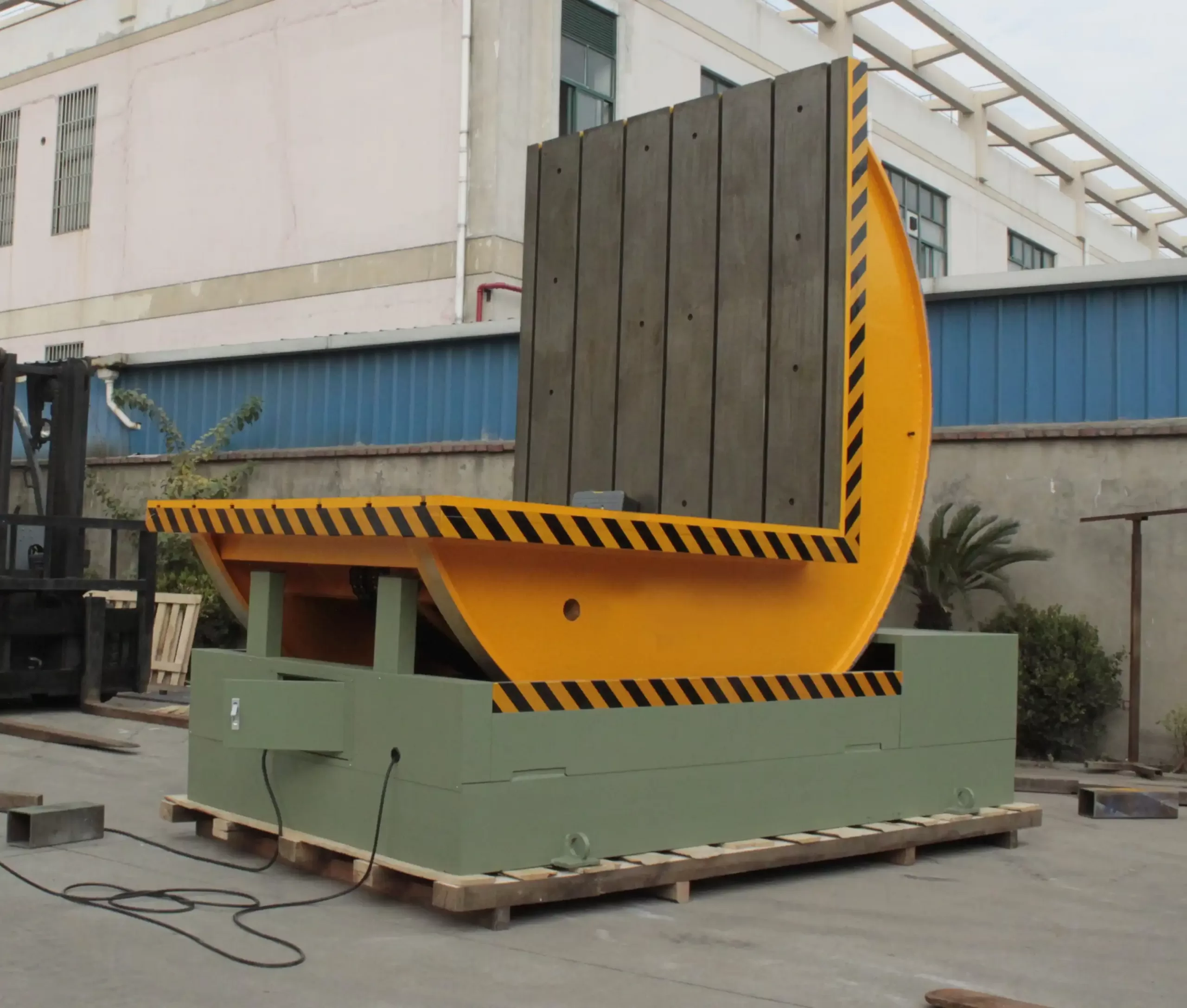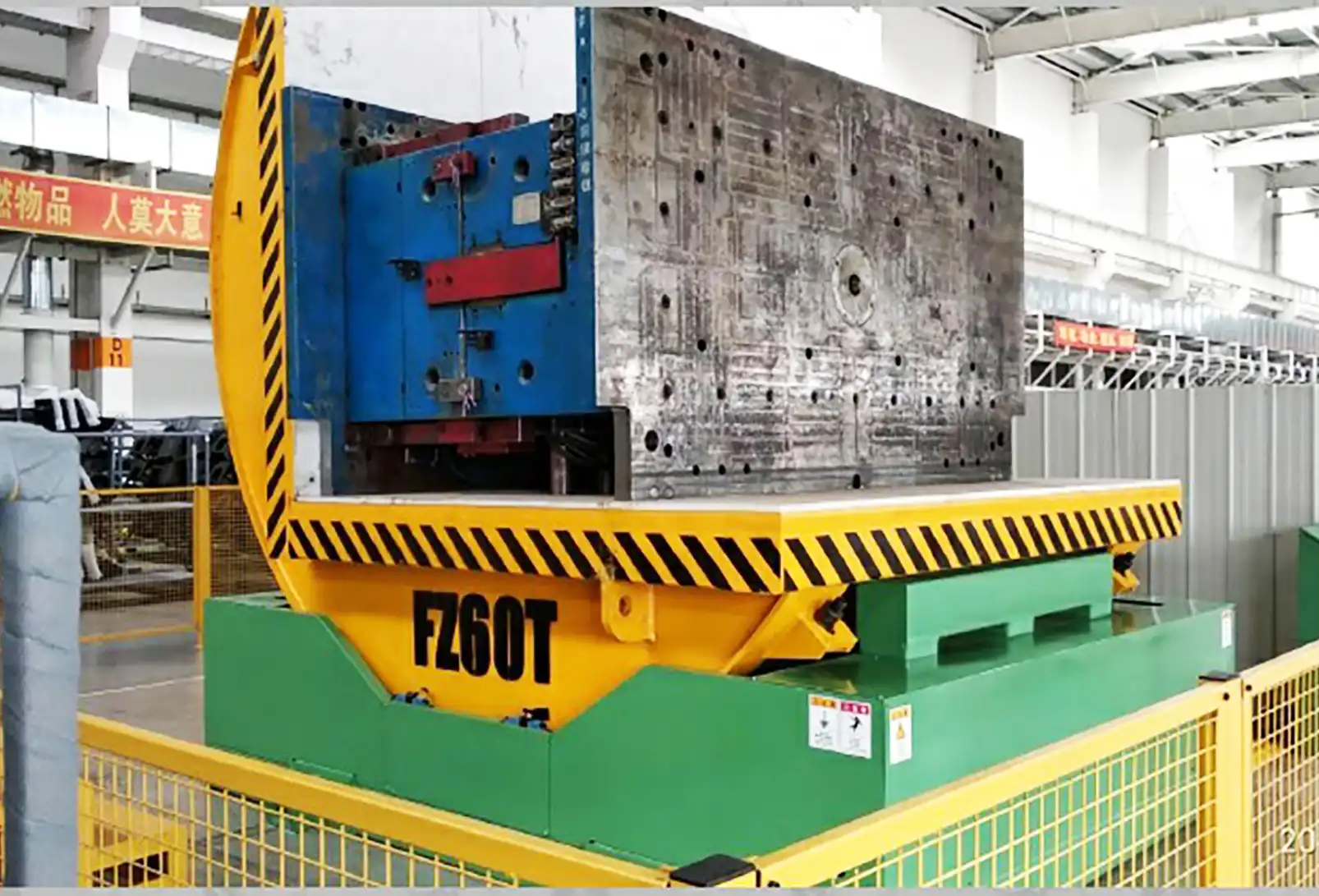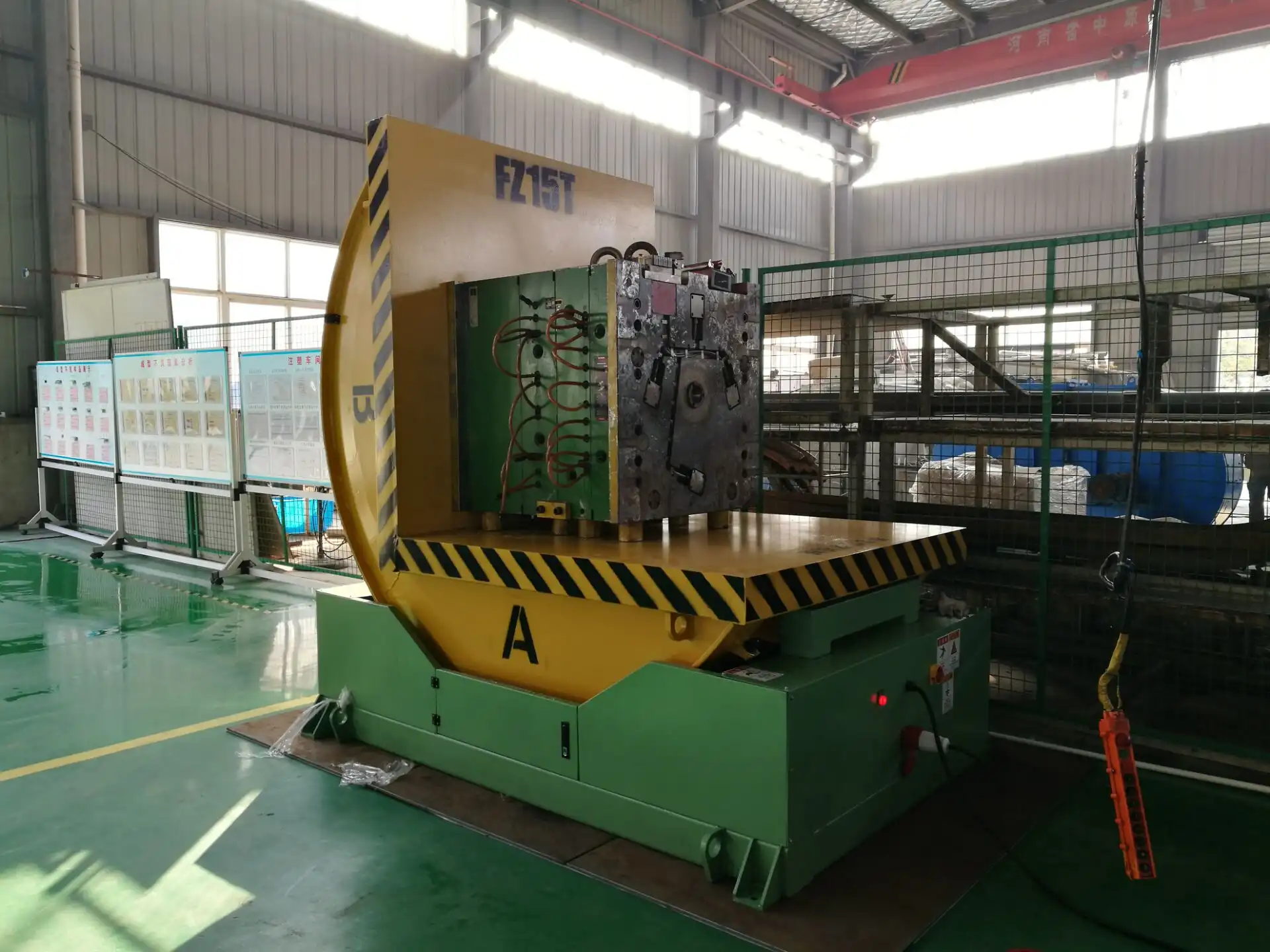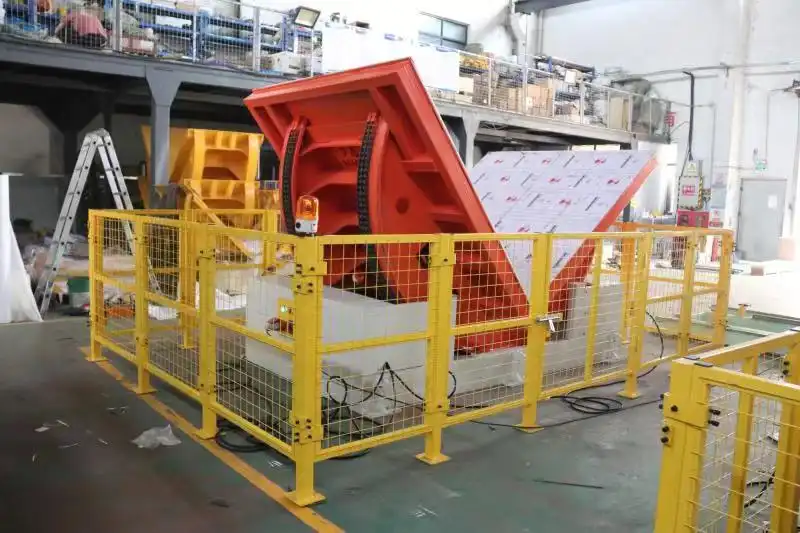Flipping a multi-ton mold is a daily task in many Brazilian tooling shops. But it is also one of the most dangerous. Using overhead cranes or multiple forklifts feels like a normal part of the job. The problem is, "normal" has become a synonym for "risky." One wrong move, one slipped chain, or one moment of miscommunication can lead to a catastrophic failure. This can injure your team, damage expensive molds, and halt production for days. As an engineer who has spent his life on the factory floor, I have seen the consequences of these high-risk operations. The financial and human cost is simply too high to ignore. There has to be a better, safer way.
The safest way to flip 1–20 ton molds is by using a dedicated mechanical mold upender, also known as a mold tilter. This machine is specifically engineered to securely clamp a mold and rotate it 90 degrees in a smooth, controlled motion. It eliminates the instability and human error associated with using cranes or forklifts for a task they were not designed for. This specialized equipment turns a dangerous, multi-person job into a safe, predictable, one-person operation.

You might think that investing in specialized equipment for a single task is an unnecessary expense. But the truth is quite the opposite. The cost of a single accident far outweighs the investment in a proper solution. This is not just about meeting safety regulations. It is about building a more efficient, reliable, and profitable operation. Let's break down why traditional methods are so flawed and how a dedicated solution transforms the entire process. This knowledge can help protect your most valuable assets: your people and your machinery.
Why are traditional mold flipping methods so risky?
Many tooling shops in Brazil continue to use overhead cranes and forklifts to flip heavy molds. This practice often seems quick and efficient. But it hides significant dangers that can surface without warning. You rely on the skill of the operator and the integrity of chains and slings. This introduces a level of unpredictability that is unacceptable in a modern industrial setting. I have seen how a routine flip can turn into a crisis, causing severe damage and putting lives at risk. The core problem is that these are general-purpose tools being used for a very specific, high-stakes task.
The primary reason traditional mold flipping methods are so risky is their lack of stability and control. When a mold is suspended from a crane, it can swing or shift unexpectedly. The center of gravity changes during the flip, creating dynamic forces that can snap chains or slings. Forklifts are not designed for the complex rotational forces involved in turning a heavy, unbalanced load. This creates numerous pinch points and crush hazards, making it an incredibly dangerous procedure for anyone nearby.

To truly understand the danger, we need to look closer at the mechanics of what is happening. It is not just about the risk of dropping the mold. The process itself is flawed. It requires a level of coordination and judgment that is difficult to maintain consistently, especially under pressure. The hidden costs associated with these methods, from minor mold damage to major accidents, accumulate over time. Acknowledging these specific risks is the first step toward creating a fundamentally safer work environment for your team in Brazil.
Crane and Forklift Flipping: A Breakdown of Dangers
Using general-purpose equipment like cranes and forklifts for flipping molds introduces multiple points of failure. Cranes, while excellent for vertical lifting, are not ideal for controlled rotation of heavy, asymmetrical objects. The mold is essentially a pendulum. Any small movement at the top translates into a large, powerful swing at the bottom. This dynamic load puts immense stress on rigging equipment. Slings and chains can slip on the smooth, oiled surfaces of a mold, and finding secure, balanced attachment points is often a matter of guesswork.
Forklifts present a different set of problems. Often, two forklifts are used in a coordinated but precarious ballet to turn a mold. This method is highly dependent on operator skill and perfect communication. The risk of a tine slipping, a hydraulic failure, or a simple miscalculation is enormous. The mold is not secured, and the machines are operating at the edge of their stability limits. The potential for the mold to topple or slide off the forks is extremely high. This not only endangers the operators but also anyone in the vicinity.
The Hidden Costs of Unsafe Practices
The most obvious cost of an accident is physical damage and personal injury. But the financial impact goes much deeper. Consider these factors:
- Mold Damage: A dropped or scraped mold can cost tens of thousands of dollars to repair or replace. Even minor damage can affect the quality of the final product, leading to increased scrap rates.
- Downtime: An accident stops production. The area must be secured, an investigation conducted, and repairs made. This unplanned downtime can disrupt schedules and lead to missed deadlines and financial penalties.
- Insurance and Liability: A history of workplace accidents can lead to higher insurance premiums. A serious injury can result in significant legal and liability costs that impact the company's financial stability.
- Team Morale: Constantly working in a high-risk environment affects employee morale and focus. A safe workplace is a productive workplace. When your team knows that their safety is a priority, they can focus on quality and efficiency.
Let's compare the risk factors in a simple table.
| Risk Factor | Overhead Crane Method | Forklift Method |
|---|---|---|
| Load Stability | Poor (Swinging Load) | Very Poor (Unsecured Load) |
| Control | Low (Dependent on operator) | Very Low (Complex coordination) |
| Pinch/Crush Hazards | High | Extremely High |
| Personnel Required | 2-3 people (including spotters) | 2-3 people |
| Risk of Mold Damage | High (from slips and impacts) | Very High (from slips/drops) |
| Cycle Time | Unpredictable | Unpredictable and slow |
This table clearly shows that both traditional methods are fundamentally flawed for this specific task. They were never designed for it.
How does a mechanical mold upender improve safety and efficiency?
You have seen the risks of using cranes and forklifts. Now, you might be wondering how a specialized machine truly solves these problems. It can seem like a large investment for one function. But the issue is that this single function is one of the highest-risk activities in your entire operation. A mold upender is not just another piece of equipment; it is an engineered safety system. It is designed from the ground up to do one job perfectly: turn heavy objects safely and efficiently. By replacing a chaotic, manual process with a controlled, automated one, you eliminate the root causes of accidents.
A mechanical mold upender improves safety by securing the workpiece on a heavy-duty, stable platform before any movement begins. The machine uses a powerful but smooth drive system, either a mechanical screw jack or hydraulics, to perform the 90-degree rotation. The entire process is controlled by a single operator from a safe distance using a simple push-button interface. This methodical approach removes the guesswork, the instability, and the potential for human error that makes traditional methods so dangerous. It also significantly boosts efficiency by turning a complex, 20-minute procedure into a simple, 2-minute cycle.

The benefits go beyond just preventing catastrophic failures. Think about the daily workflow on your shop floor. How much time is spent waiting for a crane to be available? How many people are pulled away from their primary tasks to assist with a mold flip? A mold upender streamlines this entire process. It provides a predictable, repeatable, and fast solution that integrates smoothly into your production line. Let's dive deeper into the specific mechanics of how it works and the tangible efficiency gains you can expect.
The Engineering Behind a Safer Flip
The design of a mold upender is simple but robust. It typically consists of two platforms or tables connected in an "L" shape, mounted on a heavy-duty steel frame. The mold is loaded onto the horizontal platform. The machine’s drive system then rotates the entire structure 90 degrees. As it rotates, the second platform moves to support the mold, which then rests securely on what was previously the vertical face. The entire motion is guided and controlled, preventing any sudden shifts or drops.
The key is the center of gravity management. Unlike a crane that lifts from a single point, the upender supports the entire base of the mold. As it tilts, the load is smoothly transferred from one platform to the other. There is no point where the mold is unstable or unsecured. Advanced models include features like:
- Mechanical Screw Jack Systems: These are inherently safe. They are self-locking and cannot fail or drop the load even if power is lost.
- Hydraulic Systems: These provide immense power and smooth operation, equipped with check valves and pressure relief systems to prevent catastrophic failure.
- Limit Switches and Sensors: These ensure the machine stops precisely at 0 and 90 degrees, preventing over-rotation.
- Emergency Stops: These are placed at the operator's console and on the machine itself, allowing for an instant halt in any situation.
Efficiency Gains You Can Measure
While safety is the primary driver, the efficiency improvements provide a strong financial justification for the investment. A mold upender transforms your workflow. It is not just about the time saved during the flip itself. It is about the ripple effect across your entire operation.
| Metric | Traditional Method (Crane/Forklift) | Mold Upender Method |
|---|---|---|
| Cycle Time | 15–30 minutes | 1–3 minutes |
| Personnel Required | 2–3 operators | 1 operator |
| Equipment Waiting Time | High (crane/forklift availability) | Zero (dedicated machine) |
| Risk of Mold Rework | High | Negligible |
| Process Consistency | Low | 100% Repeatable |
| Floor Space Usage | Large, unsafe area required | Small, defined footprint |
These numbers translate directly to your bottom line. Reduced labor costs, increased uptime for your production machines, and the elimination of costly rework from mold damage all contribute to a rapid return on investment. The process becomes predictable. You can schedule maintenance and changeovers with confidence, knowing that the flip will take a set amount of time, every time. This level of control is essential for any modern, lean manufacturing environment.
What key features should a tooling shop look for in a 1-20 ton mold upender?
You are convinced that a mold upender is the right solution. Now, the practical question arises: how do you choose the right one? With different manufacturers and models available, it can be hard to know what really matters. Buying a machine like this is not like buying a standard tool. It is a long-term investment in the safety and productivity of your facility. Choosing the wrong machine could mean you end up with equipment that is undersized, unreliable, or missing critical safety features. From my experience building and specifying these machines, I know that focusing on a few core features will ensure you get a machine that serves you well for decades.
When selecting a 1–20 ton mold upender for a Brazilian tooling shop, you must prioritize a robust structure, a reliable drive system, and comprehensive safety features. Look for a machine built with heavy-gauge steel and a capacity that is at least 25% higher than your heaviest mold. This provides a crucial safety margin. The drive system, whether mechanical or hydraulic, should be from a reputable brand with proven reliability. Finally, non-negotiable safety features like emergency stops, limit switches, and overload protection are essential for protecting your team and your investment.

Beyond these core components, you should also consider factors specific to your operation in Brazil. This includes the local power supply, the available floor space, and the specific size and shape of the molds you work with. A good supplier will not just sell you a machine; they will work with you to understand your needs and recommend or customize a solution that fits perfectly. Let’s break down the essential checklist you should use when evaluating a potential mold upender.
Structural Integrity and Drive System
The foundation of any good mold upender is its frame. It must be able to handle the static weight and the dynamic forces of the turning motion without any flexing or instability.
- Material and Construction: Insist on a heavy-duty, welded steel frame. Ask the manufacturer about the steel grade and plate thickness. A well-built machine feels solid and over-engineered. This is a good thing.
- Capacity Rating: Never operate a machine at its maximum limit. If your heaviest mold is 18 tons, you should be looking at a machine rated for at least 20-25 tons. This safety factor accounts for uneven weight distribution and provides long-term durability.
- Drive System—Mechanical vs. Hydraulic:
- Mechanical Screw Jack: This is my preferred system for most applications under 50 tons. It is extremely reliable, requires minimal maintenance, and is inherently safe because it cannot slip. The movement is precise and controlled.
- Hydraulic System: For extremely heavy loads (over 50 tons) or when faster cycle times are needed, hydraulics are a good option. Ensure the system uses high-quality pumps, cylinders, and hoses. It must have safety features like pilot-operated check valves to prevent the load from moving if a hose fails.
Essential Safety and Usability Features
A machine is only as safe as its control system. These features are not optional extras; they are fundamental requirements.
| Feature | Why It Is Essential |
|---|---|
| Emergency Stop (E-Stop) | Allows immediate shutdown of all motion from the control panel and the machine itself. A legal and moral must-have. |
| Limit Switches | Automatically stops the rotation at the 0 and 90-degree positions, preventing damage from over-travel. |
| Overload Protection | A sensor or clutch that stops the machine if it detects a load heavier than its rated capacity. |
| Pendant Control | Allows the operator to stand at a safe distance with a clear view of the operation. Wireless options add flexibility. |
| Leveling Feet | Ensures the machine is perfectly stable on an uneven factory floor, which is common in many facilities. |
| Durable Platform Surface | The surfaces that contact the mold should be robust. Options like polyurethane padding can protect delicate molds. |
Considerations for Brazilian Operations
Finally, think about local conditions.
- Power Supply: Ensure the machine's electrical system is compatible with Brazil's standard voltage and frequency (e.g., 220V/380V at 60Hz). A good supplier can easily accommodate this.
- Installation and Support: Does the supplier have experience shipping to Brazil? Can they provide installation support or clear documentation in Portuguese or English? Local support or a partnership with a local technician is a huge advantage.
- Environment: Is your shop dusty or humid? The machine's electrical components and paint finish should be durable enough to withstand the local industrial environment.
Choosing the right machine is a process of careful evaluation. By focusing on these key features, you ensure that your investment is sound, safe, and built to last.
My Personal Take: A Lesson from the Factory Floor
I want to share a brief story. Early in my career as an engineer, long before I started SHJLPACK, I worked in a large factory. We routinely flipped die sets weighing around 10 tons using an overhead crane. It was the "way it was always done." One afternoon, I was walking through the bay when the crew was performing a flip. I heard a loud crack, like a rifle shot. A link on one of the lifting chains had snapped under the shifting load.
The massive die set swung violently and crashed into a support column. The sound was deafening. By sheer luck, no one was standing in its path. But the incident shook the entire factory. We were lucky it was just a near-miss. That die set was ruined, the column was damaged, and production in that bay stopped for a week.
That day taught me a lesson that has stayed with me my entire life: "The way it's always been done" is one of the most dangerous phrases in manufacturing. Just because you have been lucky so far does not mean the process is safe. It just means the accident hasn't happened yet. This experience is why I am so passionate about providing engineered solutions for these specific problems. A mold upender is not just a piece of steel. It is peace of mind. It is a system that replaces luck with reliability. It is a strategic decision to protect your people, your equipment, and your business. For leaders like Javier Morales, who look at the total picture, this is the kind of forward-thinking investment that builds a resilient and successful company.

Conclusion
For Brazilian tooling shops, a mold upender is the safest way to flip heavy molds. It is a strategic investment in productivity, equipment protection, and, most importantly, your people.

